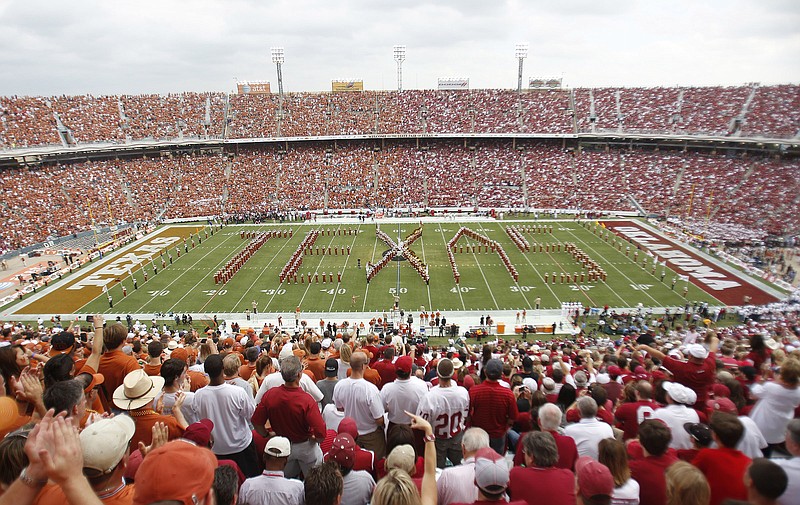AUSTIN, Texas - To get a glimpse of the Southeastern Conference's plan to dominate college football Saturdays even more, take a look at this weekend's schedule.
In Dallas, No. 6 Oklahoma and No. 21 Texas will play their annual matchup amid the revelry of the State Fair of Texas in late morning. No. 1 Alabama visits Texas A&M at sunset. In between, No. 2 Georgia plays at No. 18 Auburn in the latest edition of the Deep South's Oldest Rivalry.
Soon, all of those games will be SEC matchups. Oklahoma and Texas became future SEC schools this summer, and once stocked with the Sooners and Longhorns, the 16-team SEC will more than any other conference have the ability to put on marquee events from noon to midnight each Saturday throughout the fall.
The national reach of Oklahoma and Texas, currently Big 12 programs, should give the SEC and its broadcast partners even more power and influence over college football, expanding the league's geographic footprint while teams drill even deeper into the Lone Star State's fertile recruiting grounds.
When it happens - set now for 2025, the year after the SEC starts a 10-year broadcast rights deal with ABC and ESPN after three decades with CBS - the Red River Showdown of Oklahoma-Texas will be tucked into a league schedule already full of blood rivalries including Alabama-Auburn, Georgia-Florida and even the eventual return of Texas-Texas A&M.
Adding Oklahoma and Texas "is going to result in (the SEC) having more top-10 ranked teams versus top-10 team ranked teams," said Karl Benson, who has had stints as the commissioner of four conferences (Mid-American, Mountain West, Sun Belt and Western Athletic).
"That little saying, 'It means more.' I didn't realize just how much that meant until I lived in the SEC territory, in the SEC footprint," Benson added.
More money, for one thing.
The SEC's current broadcast deal with CBS pays about $55 million to the league annually. The SEC and ESPN are already in a 20-year deal that includes a partnership on the SEC Network, but the new ESPN deal will pay the league $300 million annually for the rights to broadcast the SEC's game of the week on ABC. The network will also be able to show SEC games on Saturday nights on ABC, a slot that is typically one of the most viewed of a college football weekend.
Measuring exposure is inexact, but television viewers and online search data offer a lens into how a conference can dominate a football Saturday.
Last weekend was the SEC's first big slate of conference games, with No. 1 Alabama and No. 2 Georgia both hosting ranked foes from within the league. ESPN had an SEC tripleheader with at least one ranked team in each game, with Ole Miss-Alabama on CBS in the midafternoon time slot given to the league's top game.
The SEC drew four of the seven largest television audiences on Saturday, with two Big Ten games and the top-10 matchup of Cincinnati-Notre Dame filling out the rest. The Big Ten did manage to outdraw the SEC online, snapping a three-week streak of the latter being the most searched conference on Saturday, according to a Google Trends search.
As the SEC increases in size and power, it will draw more eyeballs than ever each Saturday, and that can "be very impactful," said Matt Balanz senior vice president of analytics for Navigate Research, a company that projects data for college conferences and professional sports leagues.
"For example, when the SEC has a larger share of TV viewers today with its existing smaller conference, they see 50-75% more online search traffic than the rest of the (Power Five) conferences, which can lead to all kinds of important consumer behaviors, such as buying tickets and merchandise, donating and applying to the school," Balanz said.
The addition of Oklahoma and Texas means the SEC likely will add more games that attract even casual college football fans from coast to coast.
Dave Brown, a former ESPN vice president of programming, is now a consultant for schools and leagues for future schedules. The Red River Showdown is a game "anyone would want to have" and builds on the SEC's arsenal of must-see rivalries - but records and rankings in the moment still count, Brown said.
He called the Big Ten pairing of No. 3 Iowa vs No. 4 Penn State the nation's top game this week, with Georgia-Auburn on equal footing with Oklahoma-Texas. Texas A&M losing its past two games deflated the national interest in what once looked like a tasty showdown with Alabama.
While Oklahoma-Texas is a matchup of two teams in the AP Top 25 this year, there was also a three-year stretch of losing seasons by Texas from 2014-16.
"If they just don't have the records and the rankings, you're just not going to get the ratings," Brown said.
Chuck Neinas, a former commissioner of the defunct Big Eight and former interim commissioner of the Big 12, downplayed the threat of the SEC overwhelming college football by adding the Longhorns and Sooners.
"There's plenty of good teams around" Neinas said. "The Big Ten in particular. They're in a lot of markets."
Neinas did say the SEC has probably done the best job of any conference in taking a regional product and making it a national one. Benson noted he sees signs of SEC fans popping up in Colorado, where he lives.
"I don't remember it being this way earlier," Benson said, "but the number of Alabama fans and Alabama stickers and car stickers and banners and licenses plates that I see in Denver ... it's a phenomenon."
